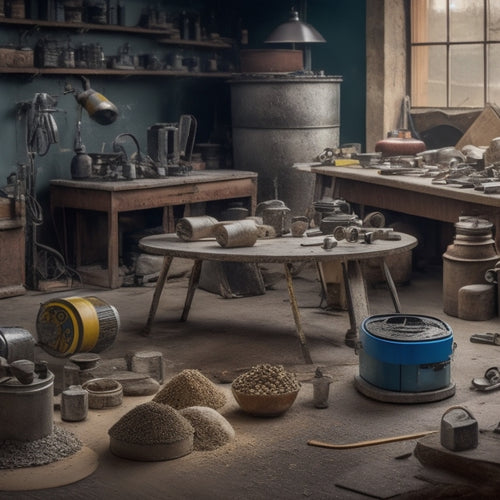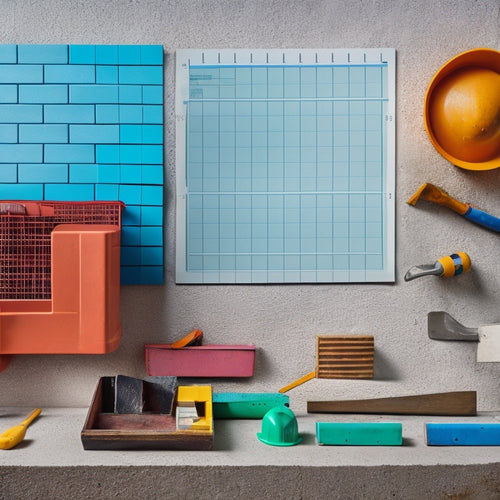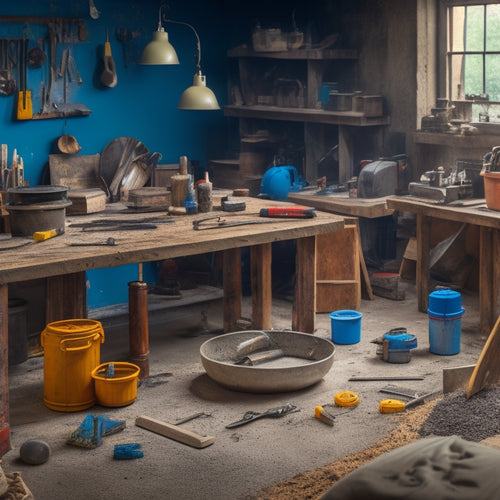
Ergonomic Concrete Tools for Tight Spaces
Share
When you're tackling concrete work in tight spaces, ergonomic tools are your best bet for comfort and efficiency. These tools often feature lightweight materials and contoured grips, reducing strain on your hands and wrists. Compact designs and adjustable heads let you maneuver into challenging spots effortlessly. Look for multi-functional tools that streamline your workflow and minimize fatigue. High-quality materials like stainless steel enhance durability while maintaining a lightweight feel. By prioritizing these features, you'll boost both productivity and precision. There's a lot more to evaluate about these specialized tools that can further enhance your performance.
Key Takeaways
- Ergonomic concrete tools reduce strain with contoured grips and balanced weight, enhancing comfort during heavy material handling in tight spaces.
- Lightweight materials and compact designs improve maneuverability, allowing users to work efficiently in confined areas without excessive fatigue.
- Adjustable heads and flexible shafts help access challenging spots while maintaining optimal control and minimizing wrist strain.
- Multi-functional tools streamline workflow, maximizing workspace utilization and improving overall productivity in concrete finishing tasks.
- Regular maintenance, including cleaning and inspections, ensures tool longevity and user safety, enhancing performance in tight spaces.
Benefits of Ergonomic Tools
Ergonomic tools are designed to reduce strain and enhance comfort, making them essential for anyone who regularly works with heavy materials like concrete. When you choose ergonomic tools, you're investing in your health and efficiency. These tools often feature contoured grips, balanced weight distribution, and adjustable components that align with your body's natural movements, which leads to reduced strain on your muscles and joints.
By minimizing discomfort during prolonged use, ergonomic tools help prevent fatigue, allowing you to maintain focus and precision in your work. This improvement in comfort can directly correlate with improved productivity. When you're not battling aches and pains, you can complete tasks more efficiently and with greater accuracy, considerably impacting project timelines and quality.
Additionally, ergonomic designs often incorporate materials that absorb shock and vibrations, further protecting you from repetitive stress injuries. This attention to your physical well-being not only enhances your capabilities on-site but also fosters a culture of safety and care within your work environment.
Ultimately, making the switch to ergonomic tools is a strategic decision that pays dividends in both your performance and your long-term health.
Essential Features for Tight Spaces
When you're working in tight spaces, having tools that are compact yet highly functional can make all the difference in maintaining efficiency and comfort.
Essential features you should look for include lightweight materials that reduce fatigue while allowing for prolonged usage. Ergonomic grips are vital; they provide better control and minimize strain on your hands and wrists during repetitive tasks.
Additionally, consider compact tool designs that enable you to maneuver effortlessly in confined areas. Tools with adjustable heads or flexible shafts will enhance your ability to reach challenging spots without compromising your posture. You'll also want to guarantee that the tools are easy to handle, allowing for quick adjustments and shifts between tasks.
Another key aspect is efficient workspace utilization. Tools that can serve multiple functions reduce the clutter and enhance your ability to work effectively in tight quarters. Look for products that integrate various functionalities without sacrificing performance.
This approach not only saves space but also streamlines your workflow, enabling you to focus on quality and precision. Prioritizing these features will elevate your work experience in confined environments, making your projects more manageable and enjoyable.
Top Ergonomic Finishing Tools
Finding the right finishing tools can greatly enhance both your comfort and precision, especially when they incorporate ergonomic designs tailored for extended use.
When selecting finishing tools, consider those made from high-quality tool materials such as stainless steel or carbon fiber. These materials not only provide durability but also contribute to a lightweight feel, reducing fatigue during prolonged projects.
Look for trowels with soft-grip handles that contour to your palm, allowing for better control over your finishing techniques. A well-designed float can also make a significant difference; choose one that offers a balanced weight distribution, which minimizes wrist strain while achieving a smooth surface.
For edges and corners, consider using ergonomic hand edgers that are optimized for grip and leverage. These tools allow you to apply consistent pressure without risking injury. Additionally, adjustable or telescoping handles in certain finishing tools can help you work comfortably in tight spaces, ensuring you maintain precision even in challenging conditions.
Ultimately, investing in ergonomic finishing tools will lead to improved results and a more enjoyable working experience, allowing you to master your craft with ease.
Comparison of Tool Designs
Comparing various tool designs reveals significant differences in functionality and user comfort, impacting both efficiency and the quality of your concrete work. When selecting ergonomic tools, you'll notice that some designs prioritize comfort, featuring cushioned grips and adjustable handles, while others emphasize lightweight materials for ease of maneuverability.
Tool aesthetics also play an essential role in your choices; a sleek, modern design not only looks appealing but can enhance your overall experience. For instance, tools with a balanced weight distribution allow you to maintain control during application, reducing fatigue over extended periods.
Additionally, consider the shape of the tool heads. Those designed with rounded edges can navigate tight spaces more effectively than square counterparts, ensuring you don't miss any spots during finishing.
The difference in materials is another important aspect. High-quality stainless steel may provide durability, while composite alternatives might offer better grip and reduce vibration.
Ultimately, the right combination of user comfort, functionality, and tool aesthetics can lead to a smoother workflow and superior results in your concrete projects. Invest time in understanding these design elements to enhance your performance and satisfaction.
User Tips for Optimal Use
To get the most out of your ergonomic concrete tools, always make certain they're properly maintained and adjusted to fit your specific needs before starting any project.
Begin by evaluating your body mechanics; verify your posture promotes user comfort while handling tools. For instance, adjust tool handles to a height that minimizes strain on your back and arms, allowing for extended use without fatigue.
Next, familiarize yourself with the tool's features. Understand how to balance weight distribution for ideal tool handling, especially in tight spaces. Using tools that are too heavy or poorly balanced can lead to awkward movements and potential injuries.
When using power tools, practice a smooth, fluid motion rather than jerky movements. This technique not only enhances user comfort but also improves precision in your work. Regularly take breaks to prevent overexertion; ergonomic tools can reduce strain, but they won't eliminate it completely.
Lastly, always wear appropriate personal protective equipment (PPE) tailored for concrete work. When you combine good tool handling techniques with proper safety measures, you'll greatly enhance both your performance and your enjoyment of the task at hand.
Maintaining Ergonomic Tools
To keep your ergonomic tools performing at their best, you'll need to reflect on several key points.
Focus on tool design aspects that enhance usability.
Employ proper maintenance techniques to extend their lifespan.
Adopt user safety practices to prevent injuries.
Tool Design Considerations
When designing ergonomic concrete tools, it's crucial to prioritize user comfort and efficiency to reduce fatigue and enhance productivity during extended use.
Focusing on design innovation can considerably improve how you handle tools in tight spaces. Here are some key considerations to keep in mind:
-
Grip Design: A contoured handle with a soft, non-slip surface can provide better control and comfort, reducing strain on your hands.
-
Weight Distribution: Tools should be balanced to prevent excessive force on your wrists and arms, allowing for easier maneuverability.
-
Adjustability: Incorporating adjustable elements can accommodate different hand sizes and preferences, ensuring a snug fit for various users.
- Durability: Use high-quality materials that withstand wear and tear, maintaining performance without compromising comfort.
Proper Maintenance Techniques
Regular maintenance of ergonomic concrete tools is essential for ensuring their longevity and peak performance, helping you avoid discomfort and fatigue during use.
Start with effective cleaning techniques; regularly remove dust and debris from tools to prevent wear. Use a soft brush or compressed air for hard-to-reach areas, especially in tight spaces where grime accumulates. For metal parts, apply a gentle solvent to combat rust, ensuring you wipe them dry afterward.
Next, consider proper storage solutions. Store your tools in a dry, climate-controlled environment to prevent moisture damage. Utilize tool racks or storage bins that keep tools organized and easily accessible, reducing the risk of accidental damage. If your tools come with protective cases, always use them for added durability.
Lastly, perform periodic inspections. Check for loose screws, cracks, or signs of wear, and address any issues immediately to maintain peak performance.
User Safety Practices
Proper maintenance not only prolongs the life of your ergonomic concrete tools but also plays an essential role in ensuring user safety during operation.
When you prioritize maintenance, you reduce the risk of accidents that stem from tool malfunction. Here are some key practices to follow:
-
Regular Inspections: Check tools for wear and tear, ensuring all components are functioning correctly.
-
Cleaning: Keep your tools free from debris and concrete residue, which can hinder performance and safety.
-
Lubrication: Apply appropriate lubricants to moving parts as per manufacturer guidelines to prevent overheating and wear.
- Safety Training: Engage in ongoing safety training to stay informed about hazard recognition and proper tool usage.
Frequently Asked Questions
What Materials Are Used in Ergonomic Concrete Tools?
When exploring ergonomic concrete tools, you'll find materials like high-strength plastics, reinforced metals, and composite materials. Their durability guarantees longevity, while design innovations enhance usability, making your concrete projects more efficient and comfortable.
Are Ergonomic Tools More Expensive Than Standard Options?
Aren't you curious about the cost comparison between ergonomic and standard tools? While ergonomic options might seem pricier initially, they often prove a long-term investment, reducing strain and enhancing productivity, ultimately saving you money.
How Do I Choose the Right Tool for My Project?
To choose the right tool for your project, analyze your project requirements first. Then, apply these tool selection tips: consider tool compatibility, performance features, and ergonomics to guarantee efficiency and comfort during operation.
Can I Use Ergonomic Tools for Other Materials Besides Concrete?
Using ergonomic tools is like having a well-fitted glove; they enhance comfort and efficiency. You can apply their benefits to various materials, ensuring you're maximizing performance across alternative material applications while reducing strain and increasing productivity.
Where Can I Purchase Ergonomic Concrete Tools?
You can purchase ergonomic concrete tools from various online retailers like Amazon or specialized construction websites. Additionally, check local suppliers and hardware stores, as they often stock these tools for your convenience and immediate needs.
Conclusion
Incorporating ergonomic concrete tools designed for tight spaces can greatly boost your efficiency and comfort on the job.
Did you know that using ergonomic tools can reduce the risk of repetitive strain injuries by up to 50%?
By choosing the right tools and techniques, you're not just enhancing productivity; you're also prioritizing your health.
Remember, investing in ergonomic equipment today can lead to a more sustainable and enjoyable work experience tomorrow.
Stay safe and work smart!
Related Posts
-

Top DIY Concrete Grinding and Polishing Tools
When selecting DIY concrete grinding and polishing tools, you'll want to take into account a range of factors to guar...
-

Reinforcement Tools Checklist for Concrete Block Walls
You'll need a range of reinforcement materials, including horizontal and vertical rebar, fiber mesh, and anchor bolts...
-

Budget-Friendly Tools for DIY Decorative Concrete Profiling
You can achieve professional-grade decorative concrete results on a budget by investing in the right combination of e...


